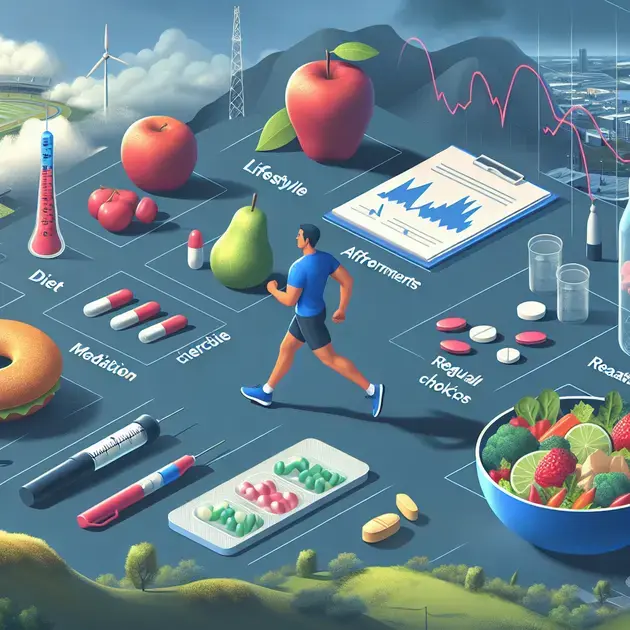Type II Diabetes is a prevalent health condition affecting millions of individuals worldwide. Understanding the causes, symptoms, and treatment options for this disease is crucial for effectively managing and improving the quality of life for those diagnosed with it.
Recent studies have shown a strong correlation between lifestyle factors such as diet, exercise, and stress levels, and the development of Type II Diabetes. By addressing these factors and adopting a holistic approach to treatment, individuals can better control their condition and reduce the risk of complications.
Common Causes of Type II Diabetes
Type II Diabetes can be caused by a variety of factors, including genetics, lifestyle choices, and underlying health conditions. One common cause is being overweight or obese, as excess body fat can make it harder for the body to use insulin effectively. Another cause is leading a sedentary lifestyle, with little to no physical activity, which can lead to insulin resistance. Additionally, genetics play a role in the development of Type II Diabetes, as having a family history of the condition can increase your risk.
To help prevent Type II Diabetes, it’s essential to maintain a healthy weight through a balanced diet and regular exercise. Monitoring your blood sugar levels regularly can also help catch any warning signs early on. By making lifestyle changes and addressing any risk factors, you can lower your chances of developing Type II Diabetes.
Apps like MyFitnessPal and Fitbit can help you track your food intake, exercise routines, and weight loss progress. Websites like the American Diabetes Association and WebMD offer valuable information on managing and preventing Type II Diabetes. By utilizing these resources, you can take proactive steps towards a healthier lifestyle and reduce your risk of developing the condition.
Recognizing the Symptoms of Type II Diabetes
Recognizing the symptoms of Type II Diabetes is crucial for early diagnosis and treatment. Common symptoms include frequent urination, increased thirst, unexplained weight loss, fatigue, and blurred vision. If you experience any of these symptoms, it’s essential to consult with a healthcare professional to assess your risk of Type II Diabetes.
One way to recognize the symptoms of Type II Diabetes is by monitoring your blood sugar levels regularly. Devices like the OneTouch Verio Flex Blood Glucose Monitoring System can help you track your levels at home. By understanding the patterns in your blood sugar levels, you can identify any potential warning signs of Type II Diabetes.
Websites like Diabetes.co.uk and Healthline provide detailed information on the symptoms of Type II Diabetes and how to differentiate them from other conditions. By educating yourself on the warning signs, you can take proactive steps towards managing your health and seeking timely medical intervention if needed.
If you suspect you may have Type II Diabetes, it’s crucial to schedule an appointment with your healthcare provider for a thorough evaluation. Early detection and treatment can help prevent complications and improve your overall quality of life.
Exploring Treatment Options
There are various treatment options available for individuals diagnosed with Type II Diabetes, ranging from lifestyle modifications to medication and insulin therapy. One common approach is to focus on dietary changes, such as reducing sugar intake, increasing fiber consumption, and monitoring carbohydrate intake.
Physical activity plays a crucial role in managing Type II Diabetes, as exercise can help lower blood sugar levels and improve insulin sensitivity. Apps like MySugr and Glucose Buddy can assist you in tracking your exercise routines and monitoring your progress towards your health goals.
In some cases, oral medications or insulin therapy may be prescribed to help regulate blood sugar levels. It’s essential to work closely with your healthcare provider to determine the best treatment plan for your individual needs. Websites like Mayo Clinic and Everyday Health offer valuable insights into the various treatment options available for Type II Diabetes.
By exploring different treatment options and finding a comprehensive approach that works for you, you can effectively manage Type II Diabetes and lead a healthy, fulfilling life. Regular monitoring, adherence to medication regimens, and ongoing communication with your healthcare team are key components of successful diabetes management.
**Understanding Type II Diabetes Causes**
Causes of Type II Diabetes
There are several factors that can contribute to the development of Type II Diabetes. One of the main causes is genetics, as individuals with a family history of diabetes are at a higher risk of developing the condition. Additionally, being overweight or obese can increase the likelihood of developing Type II Diabetes, as excess body fat can make the body more resistant to insulin.
Another significant factor is an inactive lifestyle. Lack of physical activity can lead to weight gain and increase the risk of insulin resistance, which can ultimately result in Type II Diabetes. Poor diet choices, such as consuming high amounts of sugary drinks and processed foods, can also play a role in the development of the condition.
Furthermore, age can be a factor in the development of Type II Diabetes, as the risk of the disease increases with age. Ethnicity can also influence the risk, with certain populations being more predisposed to developing diabetes. Other risk factors include high blood pressure and high cholesterol levels.
Overall, Type II Diabetes is a complex condition with multiple contributing factors. It is important for individuals to be aware of these causes in order to take preventive measures and reduce their risk of developing the disease.
Prevention of Type II Diabetes
Preventing Type II Diabetes involves making healthy lifestyle choices. Maintaining a balanced diet that is rich in fruits, vegetables, whole grains, and lean proteins can help prevent the development of the condition. Limiting the consumption of sugary foods and drinks, as well as processed foods high in fats and sugars, is also important.
Regular physical activity is crucial in preventing Type II Diabetes. Engaging in regular exercise, such as walking, jogging, cycling, or swimming, can help maintain a healthy weight and improve insulin sensitivity. Losing weight, if necessary, can also reduce the risk of developing the disease.
Monitoring blood sugar levels and maintaining a healthy blood pressure and cholesterol levels are key components of diabetes prevention. Regular check-ups with healthcare providers can help individuals stay informed about their health and take necessary actions to prevent Type II Diabetes.
By adopting a healthy lifestyle that includes a balanced diet, regular exercise, and routine health screenings, individuals can significantly lower their risk of developing Type II Diabetes and improve their overall well-being.
**Identifying Symptoms of Type II Diabetes**
Symptoms of Type II Diabetes
Identifying the symptoms of Type II Diabetes is crucial for early diagnosis and treatment. Common symptoms of the condition include frequent urination, increased thirst, and unexplained weight loss. Individuals with Type II Diabetes may also experience fatigue, blurred vision, and slow-healing wounds.
Other symptoms include numbness or tingling in the hands or feet, recurrent infections, and darkened skin patches. It is important to note that some individuals with Type II Diabetes may not exhibit any symptoms, which is why regular screenings and health check-ups are important for early detection.
If left untreated, Type II Diabetes can lead to serious complications, such as nerve damage, heart disease, and kidney problems. Therefore, recognizing the symptoms of the disease and seeking medical attention promptly is essential for managing the condition and preventing further health issues.
If you experience any of these symptoms or suspect that you may have Type II Diabetes, it is crucial to consult with a healthcare professional for proper evaluation and diagnosis. Early detection and treatment can help individuals with Type II Diabetes lead a healthier and more manageable life.
**Treatment Choices for Type II Diabetes**
Treatment Options for Type II Diabetes
Managing Type II Diabetes involves a combination of lifestyle modifications, medication, and regular monitoring. One of the key aspects of treatment is adopting a healthy diet that focuses on controlling blood sugar levels and maintaining a healthy weight. This may involve limiting the intake of carbohydrates, sugars, and fats, while emphasizing the consumption of whole foods and fiber-rich sources.
Regular exercise is also an essential component of managing Type II Diabetes. Engaging in physical activity can help improve insulin sensitivity, lower blood sugar levels, and support weight management. Individuals with diabetes are encouraged to incorporate both aerobic exercise, such as walking or cycling, and strength training into their routine.
In some cases, medication may be prescribed to help regulate blood sugar levels. This may include oral medications that help the body use insulin more effectively or injectable insulin therapy for individuals who require additional support in managing their blood sugar. It is important for individuals with Type II Diabetes to work closely with their healthcare provider to determine the most appropriate medication regimen.
Regular monitoring of blood sugar levels is crucial for managing Type II Diabetes effectively. This may involve self-testing with a glucose meter at home or periodic blood tests at a healthcare facility. By staying vigilant about blood sugar levels and making necessary adjustments to their treatment plan, individuals with Type II Diabetes can better control their condition and prevent complications.
Conclusion
In conclusion, understanding the causes, symptoms, prevention, and treatment options for Type II Diabetes is crucial for individuals looking to manage their health effectively. Genetics, lifestyle factors, age, and ethnicity all play a role in the development of this complex condition. Being aware of the risk factors and making informed choices can significantly reduce the likelihood of developing Type II Diabetes.
Prevention of Type II Diabetes involves maintaining a healthy lifestyle with a balanced diet, regular exercise, and monitoring of vital health indicators. By focusing on consuming nutrient-dense foods, staying physically active, and staying on top of health screenings, individuals can proactively reduce their risk of diabetes and improve their overall well-being.
Furthermore, early identification of symptoms, such as frequent urination, increased thirst, and fatigue, is critical for prompt diagnosis and treatment. Seeking medical attention and adhering to a personalized treatment plan that includes lifestyle adjustments, medication, and monitoring of blood sugar levels can help individuals effectively manage Type II Diabetes and prevent potential complications in the long run.

